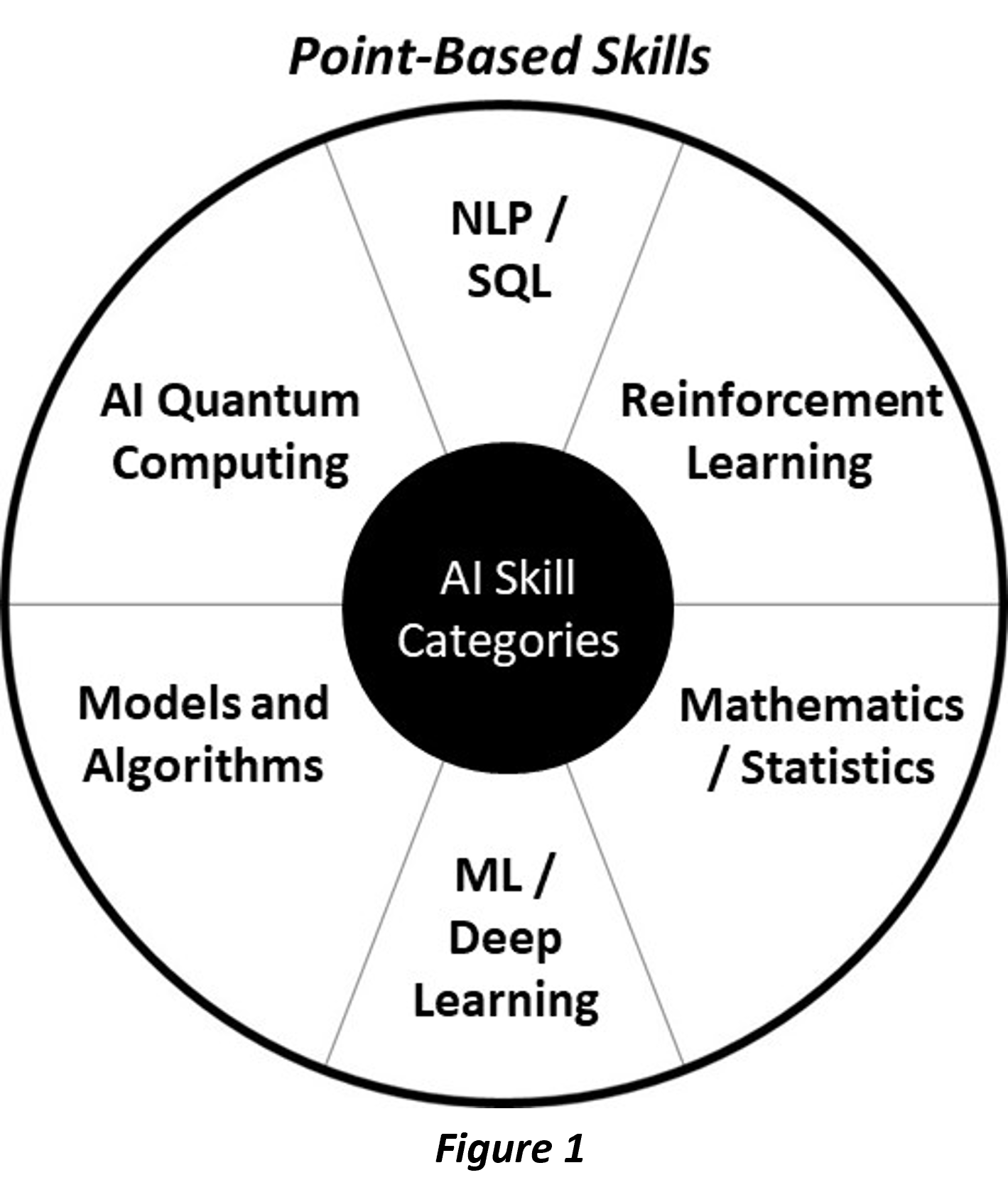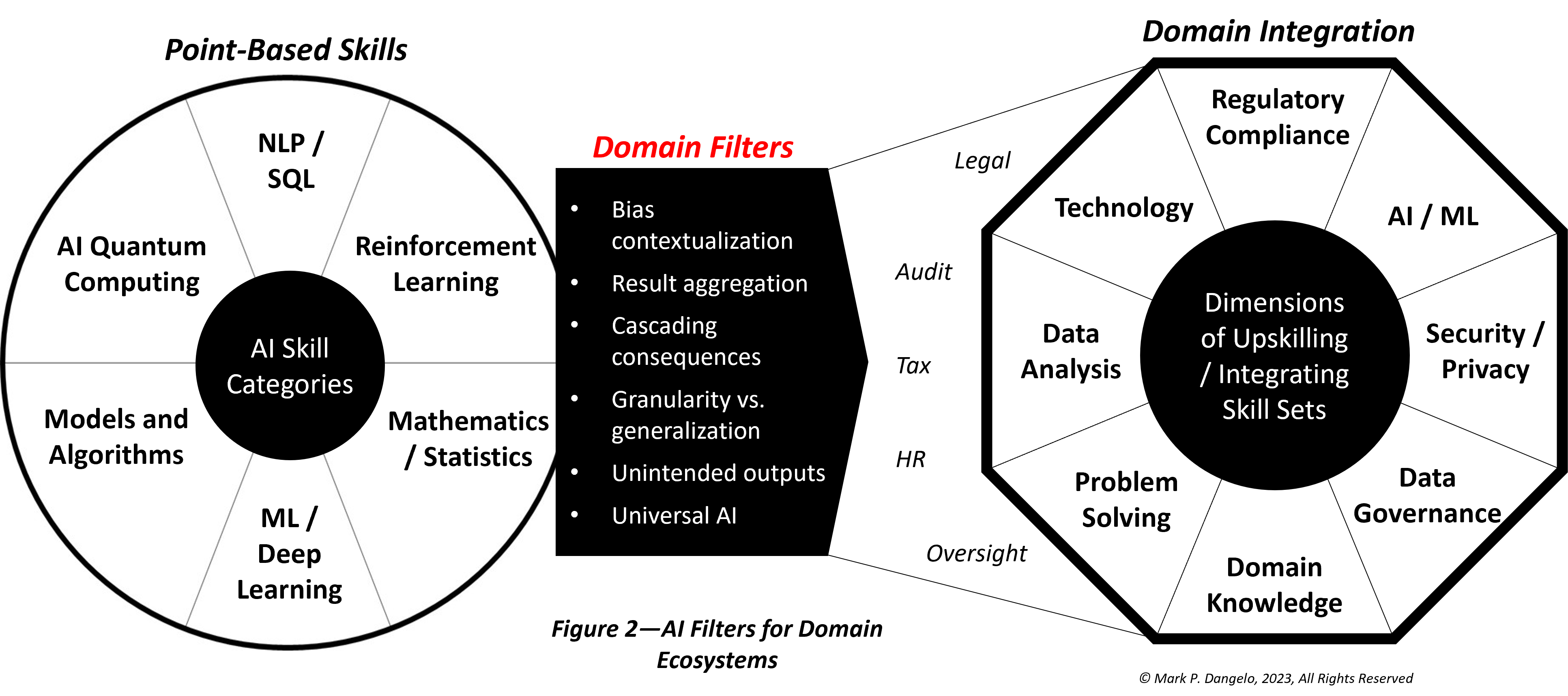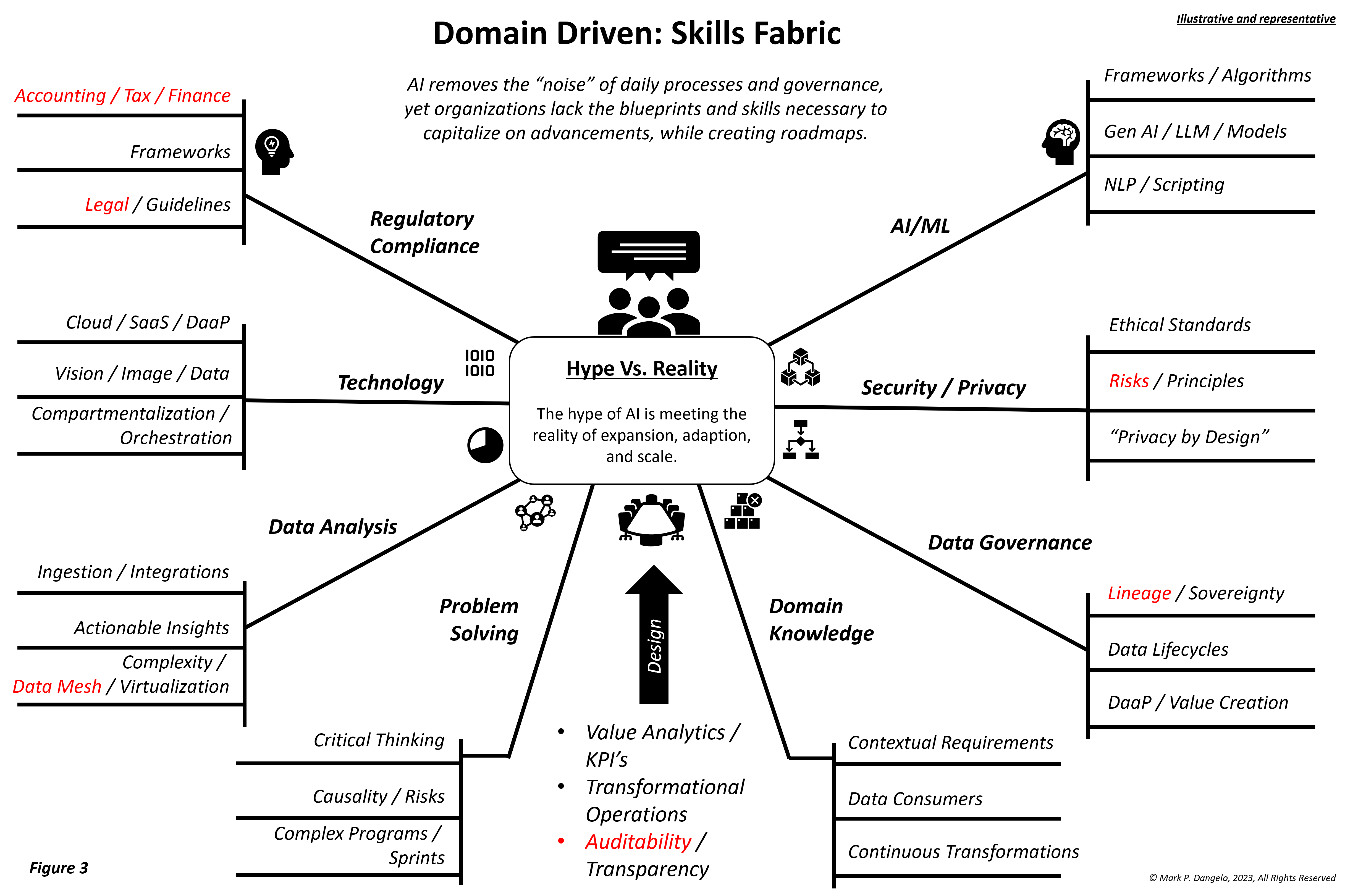Generative artificial intelligence (Gen AI) has become the “hammer in search of a nail.” While its potential is massive, the lagging skills necessary to adapt and sustain AI solutions require an innovatively relevant domain approach that delivers across a fabric of capabilities implemented underneath the critical lens of regulatory oversight
Lawyers, accountants, researchers, and regulatory compliance leaders intuitively know from experiential learning that context is critical. When it comes to finding and securing talent across segmented ecosystems of artificial intelligence (AI), training providers and hiring managers will seek out advanced skills, cultural fit, and commitment with individuals who they believe can deliver results. Additionally, piecemeal regulations from federal agencies, executive branch directives, and state legislators expose the risks and liabilities hidden across many AI solutions.
Complicating AI personnel skills are a void of capabilities against changing technological demands. Additionally, the post-pandemic return to work conflict is actively being argued in state and federal courtrooms. And while academia can teach AI fundamentals, it is less certain if they can deliver plug-and-play skills that are transferable to the specific context surrounding complex domain requirements.
As we look to 2024, the demand for machine learnings (ML) and AI skills to augment traditional industry approaches has a resemblance to the prior talent rush to secure data scientists. AI’s productivity explosion driven by data represents very material opportunities — yet many professional service firms cannot ignore the other dimensions of skills necessary for success.

However where are the decision points between AI skills, personnel potential, and cultural fit for those firms seeking leading edge Gen AI and related solutions? Where does hype meet reality? Can a skill in the ecosystems of AI categories (see the above chart) transform the complexities of delivery for consumers, industries, and more importantly, society? And how will these categories be woven into a fabric of capabilities that leverages human involvement, industry knowledge, and technology advancements?
Putting the hype into context using domain requirements
The sprint for AI skills is now turning into a marathon. The human-in-the-loop leverage is not keeping up with AI technological implementations. While the barriers of practicality, costs, and accessibility were shattered with the release of Chat GPT 3.5, it has upended traditional domains of legal, tax & accounting, oversight, and regulatory compliance. Additionally, AI across its various forms has revolutionized complex disciplines of corporate and M&A due diligence, supply chain management, product research and delivery, and hundreds of domain-specific use-cases.
Today’s corporate discussions revolve around Gen AI accuracy, data privacy, and security, while leaders struggle with obtaining needed skills and alleviating worker fears. Moreover, every week there are dozens of new AI applications introduced that allow adopters the ability to create unprecedented results with outputs that move beyond textual chats and into images, visions, and even synthetic, bi-directional speech.
Now with traditional software vendors heavily invested in AI, their sights turn to chip-enabled processing, speed, and capabilities. The expansion of the AI ecosystems is multi-dimensional, yet skills and their evolution into top-of-mind struggles are often due to preconceived ideas on screening, hiring, and even academic curriculum. The chart below provides a conceptual framework that filters AI categories and their relationship of integration across domain requirements.

As illustrated above, the quest for dynamic, advanced AI skill sets is made more disruptive due to rapid cycling of complex AI algorithms and the overwhelming oceans of captured, but unused data.
Reinforcing the premise of complex skills challenges, Swami Sivasubramanian, Amazon’s vice president of data and AI, stated: “(AI) is going to be the most transformative technology we encounter, but it won’t reach its full potential unless we really have the workforce ready to embrace it and turbocharge it in a big way.” To reinforce their supposition, Amazon has launched its AI Ready program with the goal of up-skilling two million of its workers by the start of 2025. Not surprisingly, Microsoft — an investor in Open AI Chat GPT — and IBM have similar programs in the works.
Incorporating AI skills into industry models
It is estimated that in 2024, IT spending will exceed $5.1 trillion. AI spending will push past $550 billion, and there will be a hiring gap estimated to approach 50% of all AI positions needed. Moreover, the existing personnel up-skilling demand could approach 70% of workers needing such a skills upgrade. What will enterprises do — hire AI skilled employees, hire contractors, outsource solutions, recruit more at colleges, or invest in existing individuals?
Industry leaders are experiencing unprecedented challenges with workers who may be fearful of a future in which AI reduces cycle-times, improves customer self-service, delivers progressive quality-of-service, and even eliminates functions once immune to obsolescence (such as actors). The implications of both the progress and the drawbacks force organizational compliance into uncharted, opaque operational roadmaps and implementation outcomes mostly because of a lack of robust AI skills integrated across domains.
However, one framework solution to improve the AI skill efficacy is to blend point skills (such as those in the previous charts) into a holistic fabric of domain skills. The chart below represents evolving lessons learned from teaching college students in advanced technology and innovation. This representation illustrates the multiple endpoints in which emerging AI skills will be integrated. The framework also addresses the drawbacks with traditional educational approaches (such as colleges or AI camps) where skills are taught but their applicability and cost-benefits to real-world situations are difficult to assess.

The above chart also represents an orchestration of management core competencies that provides adaptability against continually changing business drivers, AI technologies, and customer models. As AI evolves, the framework remains constant allowing for inclusions and retirement of skills, while delivering up-skilling and acquisition roadmaps that maximize personnel investment while mitigating risks and constraints.
Nonetheless, this domain-driven framework, stretching across the rapid cycling AI ecosystems, also provides those within the legal, audit, tax, and compliance disciplines to leverage their own experiential assets in custom, value-added capabilities that builds on AI’s advancements — and is not a replacement for experience. Firms and departments in this area now have correlated methods to assess risks, devise mitigation strategies, introduce new balance and controls, and most importantly, reduce opaque liabilities not known without the application of AI (i.e., data) fully ingested across the entire framework.
In the end, the consequences of procuring AI skills using traditional mindsets are likely to deliver historically comparable results and pain points (such as over-promising and under-delivering) in a rush-to-capitalize on technology advancements.
Yet, the reality is that point-based training, education, and up-skilling will continue to produce limited results. Without a domain-context framework, corporations can check-the-box for securing next-gen AI skills, but they will conform to the same historical technology inclusion limitations. In 2024, piecemeal domestic and international AI governing bodies will continue to make skills requirements even more opaque.
Indeed, AI progression is massive, but the inclusion of innovatively relevant skills still models traditional organizational, cultural, and performance mindsets of what constitutes a valuable employee. Next-gen technology requires a new age solution to achieve the right skills set in an organization’s workforce composition — it requires a new framework for skills inclusion.







